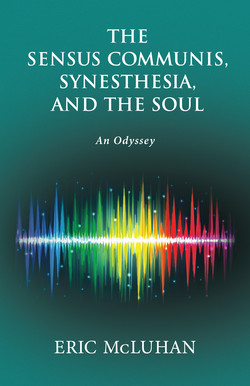The Sensus Communis, Synesthesia, and the Soul

Реклама. ООО «ЛитРес», ИНН: 7719571260.
Оглавление
Eric McLuhan. The Sensus Communis, Synesthesia, and the Soul
Foreword Is Forewarned
Faith
Then the Respondeo:
The second of the four sub-poems, “East Coker,” performs the allegorical role in Four Quartets. It opens with:
The next poem, “The Dry Salvages,” puts on tropology:
Finally, “Little Gidding” performs the level of anagogy, the mystical world between inner and outer worlds; it begins:
Synesthesia
He goes on:
Moreover, he finds that he can read voices like a book
Toward that end, let us catch a little more of Lusseyran’s remarkable account:
At one point, Lusseyran decides to test it, to resist it and see what would result:
He does not hesitate to ascribe a spiritual character to his interiorized knowing:
Pope Francis offers some apposite remarks about faith and light in his first encyclical:
This kind of observation echoes the mystical experience of Scripture:
Becoming Discarnate
In the matters we have been examining in these pages, we have found that there is not one kind of sensus communis, but there are two: one sensus communis relating to the physical body, and one relating to the intellect, the soul. Accordingly, there must then be two ecologies: one of the body and corporal senses, and one of the soul and intellectual senses
Pope John Paul II further emphasizes that hope embraces not only our ultimate salvation but also the resurrection of the body:
The hope of which John Paul II speaks is no wistful desire, no wishful thinking, but, as he says, a certainty:
The three theological virtues have been yoked together from the first: St. Paul speaks of them as a unit, as “these three.”111 It remains only to add that they are senses, and not passive senses but active powers of the soul. But do they actually form a separate sensus communis?
Asked in what way the Bible and the tradition of interpretation attribute “equality” to women while simultaneously excluding them from the priesthood, John Paul responds:
Religion
Appendix Two. Communication Arts in the Ancient World162
Appendix Three. Paradoxes of the Mass Audience167
Appendix Four. Literacies
In no particular order, then, we find:
Appendix Five. Effects of the Discarnate
And here are some reminiscences of those Blindfold Exercises 1973/1974: selected passages from a journal by Dean M., one of the participants
Lights Out
Day to Day
The Great Outdoors
That’s Entertainment
Afterwards
Addendum
Appendix Eight. The Future of Humanity, Etc
Bibliography
Отрывок из книги
SENSUS COMMUNIS,
SYNESTHESIA,
.....
This being established, it is clear that the subject about which these two senses play must also be twofold. And thus it should first be noted what the subject of the work is when taken according to the letter, and then what its subject is when understood allegorically. The subject of the whole work, then, taken literally, is the state of soul after death, understood in a simple sense; for the movement of the whole work turns upon this and about this. If on the other hand the work is taken allegorically, the subject is man, in the exercise of his free will, earning or becoming liable to the rewards or punishments of justice.55
Now let us shift from the thirteenth century to the twentieth. T. S. Eliot composed his masterpiece, Four Quartets, by bringing together the inner sensus communis and the outer sensus communis, the whole consort dancing together in poetic synesthesia. Four tightly interlaced poems comprise the overall poem. each of these four poems has five movements, patterned after the five divisions of rhetoric, inventio, dispositio, elocutio, memoria, and pronuntiatio.56 The first of the constituent poems, “Burnt Norton,” sets the scene as performing the historical level. it opens with:
.....